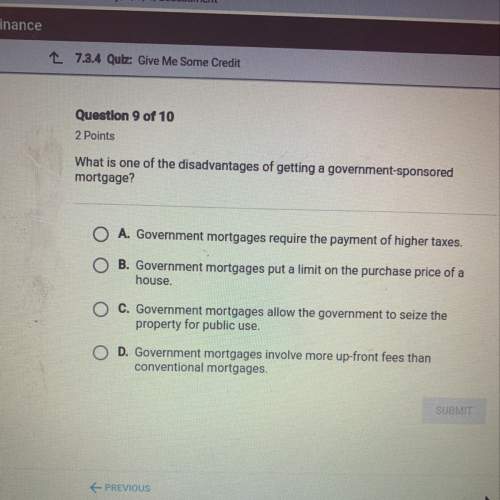
Round Hammer is comparing two different capital structures: An all-equity plan (Plan I) and a levered plan (Plan II). Under Plan I, the company would have 180,000 shares of stock outstanding. Under Plan II, there would be 130,000 shares of stock outstanding and $1.49 million in debt outstanding. The interest rate on the debt is 6 percent and there are no taxes.
Required:
a. If EBIT is $400,000, what is the EPS for each plan? (Do not round intermediate calculations and round your answers to 2 decimal places, e. g., 32.16.)
b. If EBIT is $600,000, what is the EPS for each plan? (Do not round intermediate calculations and round your answers to 2 decimal places, e. g., 32.16.)
c. What is the break-even EBIT?

Answers: 1


Other questions on the subject: Business

Business, 22.06.2019 12:30, samreitz1147
howard, fine, & howard is an advertising agency. the firm uses an activity-based costing system to allocate overhead costs to its services. information about the firm's activity cost pool rates follows: stooge company was a client of howard, fine, & howard. recently, 7 administrative assistant hours, 3 new ad campaigns, and 8 meeting hours were incurred for the stooge company account. using the activity-based costing system, how much overhead cost would be allocated to the stooge company account?
Answers: 1

Business, 22.06.2019 16:50, bri663
Coop inc. owns 40% of chicken inc., both coop and chicken are corporations. chicken pays coop a dividend of $10,000 in the current year. chicken also reports financial accounting earnings of $20,000 for that year. assume coop follows the general rule of accounting for investment in chicken. what is the amount and nature of the book-tax difference to coop associated with the dividend distribution (ignoring the dividends received deduction)?
Answers: 2

Business, 22.06.2019 19:00, FoxGirl1971
1. regarding general guidelines for the preparation of successful soups, which of the following statements is true? a. thick soups made with starchy vegetables may thin during storage. b. soups should be seasoned throughout the cooking process. c. finish a cream soup well before serving it to moderate the flavor. d. consommés take quite a long time to cool.
Answers: 2

Business, 22.06.2019 21:50, peno211
Required: 1-a. the marketing manager argues that a $5,000 increase in the monthly advertising budget would increase monthly sales by $9,000. calculate the increase or decrease in net operating income. 1-b. should the advertising budget be increased ? yes no hintsreferencesebook & resources hint #1 check my work 8.value: 1.00 pointsrequired information 2-a. refer to the original data. management is considering using higher-quality components that would increase the variable expense by $2 per unit. the marketing manager believes that the higher-quality product would increase sales by 10% per month. calculate the change in total contribution margin. 2-b. should the higher-quality components be used? yes no
Answers: 1
You know the right answer?
Round Hammer is comparing two different capital structures: An all-equity plan (Plan I) and a levere...
Questions in other subjects:

Mathematics, 10.04.2021 04:40




History, 10.04.2021 04:40

Business, 10.04.2021 04:40

Chemistry, 10.04.2021 04:40

Mathematics, 10.04.2021 04:40






